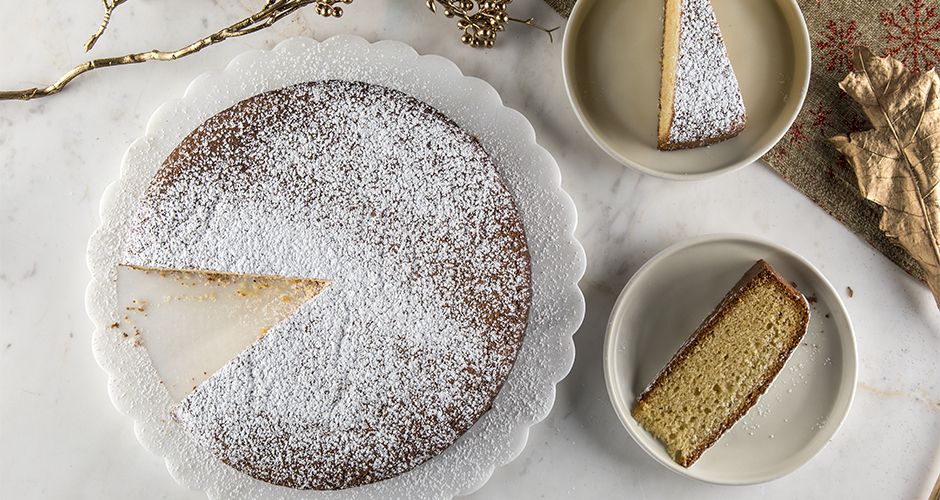START BOOKING YOUR TRIP TO
** Please note that we get a small commission if you book via our referral links. We use this to invest in new foodie content and to update the Greece Foodies website.
Greek New Year’s Cake, also known as Vasilopita cake, is a Greek tradition that has been passed down for decades. The famous Greek pastry symbolizes the new year’s coming and brings luck to those who partake in its deliciousness!
Greek families worldwide celebrate Greek New Year’s Day by cutting a slice of this sweet treat and then hiding a coin or other lucky charm inside for the lucky recipient. Greek New Year’s Cake is traditionally made with layers of phyllo dough filled with chopped walnuts and sweetened with honey syrup.
A brief history of the Greek New Year’s Cake
The cake is not just flavorful and mouthwatering but also holds a special place in Greek culture that has been passed down from generation to generation. Greek New Year’s Cake is an important tradition that helps bring families and friends together, whether near or far.
The origins of vasilopita may be traced back to the ancient festivals of Kronia and Saturnalia and are linked to a Saint Basil tale. He reportedly begged the people of Cesarea, where he was born, to gather funds to end a siege. Every resident was expected to contribute whatever they could in the shape of money or jewels.
When the ransom was turned over to the siege, those in charge were so embarrassed by the communal generosity that the siege was called off. When Saint Basil sought to restore the goods to each Caesarean, he discovered that there was no method to discern how the monies should be distributed back to the people. To address this issue, he baked the cash and jewels into bread and then gave them to the populace in this manner.
Every year, people prepare this bread in honor of Saint Basil, also known as Agios Vasilios. From the original narrative, the practice has expanded, and whoever finds the hidden coin is considered to enjoy good luck for the rest of the year. On the other hand, the bread serves as a remembrance of everything that Agios Vasilios did for the people of Greece.
Greek New Year’s Cake: Vasilopita recipe

Ingredients
- Whole milk, lukewarm
- Sugar
- Active dry yeast
- All-purpose self-raising flour
- Eggs, at room temperature
- Sugar
- Pure vanilla extract
- All-purpose flour
- Ground mahlab
- Ground mastic gum
- Zest of 2 oranges
- Salt
- Butter softened and cut into cubes
- Sesame seeds or sliced almonds for garnish
- Powdered sugar for dusting
- A coin wrapped in foil
- 1 egg yolk mixed with 2 tablespoons milk
You can put the orange juice, lemon juice, baking powder, icing sugar, chocolate sprinkles, baking soda, and a butter-sugar mixture as extras.
Execution
- Combine the milk, yeast, sugar, and flour in the bowl of a stand mixer. Allow it to rest for 10 minutes until the yeast activates—a cloud will form on top of the mixture as soon as the yeast activates.
- Sift the flour, sugar, and salt into a separate dish. Then stir in the orange zest and crush the mahlab.
- Add the eggs, remaining sugar, and vanilla extract to the active yeast mixture.
- Then, combine the flour and wet ingredients and knead for 15 minutes. The dough will resemble a batter.
- After kneading, add the softened butter cubes and mix until fully integrated. If using additional fillings, add them now and knead until well combined.
- Transfer the dough to a large mixing basin sprayed with two tablespoons of olive oil.
- Set aside for 2 hours, covered with plastic wrap or a clean kitchen towel, to rise until twice in size.
- Line a 10-inch round by 3-inch deep baking pan with parchment paper and grease it.
- Then, push the dough down to release the air and place it in the prepared baking pan.
- Wrap a coin in aluminum foil and insert it into the cake.
- Cover the pan loosely with plastic wrap and leave it aside for 30 minutes to rise.
- Preheat the oven to 350 degrees Fahrenheit (180 degrees Celsius).
- Top with sesame seeds or sliced almonds after brushing with egg wash.
- Bake for 1 hour, medium speed, or until the top has become a deep mahogany color and a toothpick inserted into the middle comes out clean.
- Allow an hour for it to cool fully.
- Remove from pan and replace with the next year’s numbers.
It’s cooking time!
Sum up
On New Year’s Eve, Vasilopita is traditionally served. Because the creamy butter complements it wonderfully, I serve it with butter and hot Greek coffee. It’s the ideal dessert for ringing in the new year. Add your favorite fillings and have fun deciding who gets the slice with the coin.
So, if you haven’t yet had the chance to taste Greek New Year’s Cake, be sure to give it a try this time! It’s certain to be just as sweet and lucky as it has been for generations! Greek recipes are just like that!
















